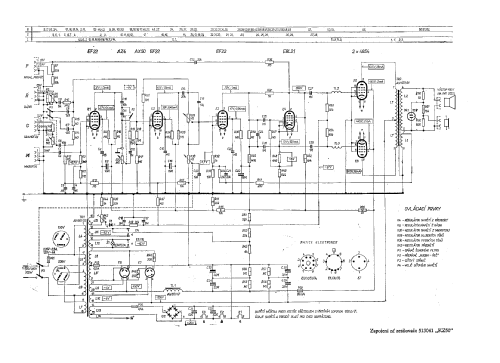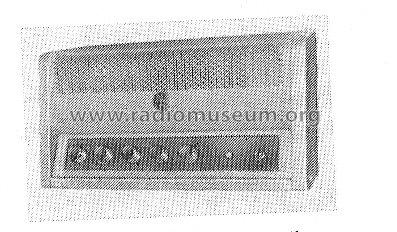KZ50 513042
Tesla; Praha, Bratislava etc.
- Country
- Czechoslovakia
- Manufacturer / Brand
- Tesla; Praha, Bratislava etc.
- Year
- 1952–1954
- Category
- Audio Amplifier or -mixer
- Radiomuseum.org ID
- 91181
-
- Brand: Supraphon
Click on the schematic thumbnail to request the schematic as a free document.
- Number of Tubes
- 8
- Main principle
- Audio-Amplification
- Wave bands
- - without
- Power type and voltage
- Alternating Current supply (AC) / 120; 220 Volt
- Loudspeaker
- - This model requires external speaker(s).
- Power out
- 50 W (unknown quality)
- Material
- Metal case
- from Radiomuseum.org
- Model: KZ50 513042 - Tesla; Praha, Bratislava etc.
- Shape
- Tablemodel, low profile (big size).
- Notes
- Tischverstärker; Eingang für Tonabnehmer, Plattenspieler, Mikro, Radio; Ausgang 100 V/200 Ω, Übertragungsbereich: 50...10000 Hz.
- Source of data
- Ceskoslovenske Rozhlasove a Televizni Prijimace a Zesilovace
- Author
- Model page created by Wolfgang Lill. See "Data change" for further contributors.
- Other Models
-
Here you find 1832 models, 1140 with images and 643 with schematics for wireless sets etc. In French: TSF for Télégraphie sans fil.
All listed radios etc. from Tesla; Praha, Bratislava etc.
Forum contributions about this model: Tesla; Praha,: KZ50 513042
Threads: 1 | Posts: 1
I received this message from guest Jan Schmidt in Prague, Czech Republic:
E. Kottek: Czechoslowak Radio and TV Receivers III and Ampliifers,
Prague, SNTL, 1973, in the chapter 6.103, Table amplifiers 513041
and 513042, "KZ50" (my translation):
"In the 513041 version, mostly an AX50 tube was used as the plate voltage rectifier
for the power stage; in the 513042 version, an AZ12N (an AZ12 with pin base)
or a PV200/600 tube was used. If the protective resistors R45 and R46
in anodes have the value of 50 ohm, all three above mentioned rectifier tube
types can be used".
Based on the KZ50 schematics, 4654 and AX50 data, I can estimate the output
of the rectifier as 560V at 160mA at full power output of the amplifier.
This is well within limits for PV200/600 and AX50, but outside of AZ12
ratings for 2x500V input (120mA, not 100mA as in the description of AZ12N
in RMorg pages). If I understand the reasons for current downscaling of the AZ12,
the danger here is arcing, not shortened life of the tube. Moreover,
KZ50 is a B class amplifier, and the actual peak current is much less
than the estimated value in the case of usual audio signal.
The amplifier uses an AZ4 rectifier for the rest of the circuit. Using an AZ12N
we get a truly bizzare settng - two identical tubes, one with a P socket, the other
one pin-based.
All this probably indicates that, at least in this case, the AZ12N was intended
as an emergency replacement of more powerful (imported) rectifiers, not
for the RGN2004 series as suggested in the text and discussion at RMorg.
Best Regards
Jan Schmidt
Thank you for this information including translation.
Ernst Erb, 13.Nov.11

